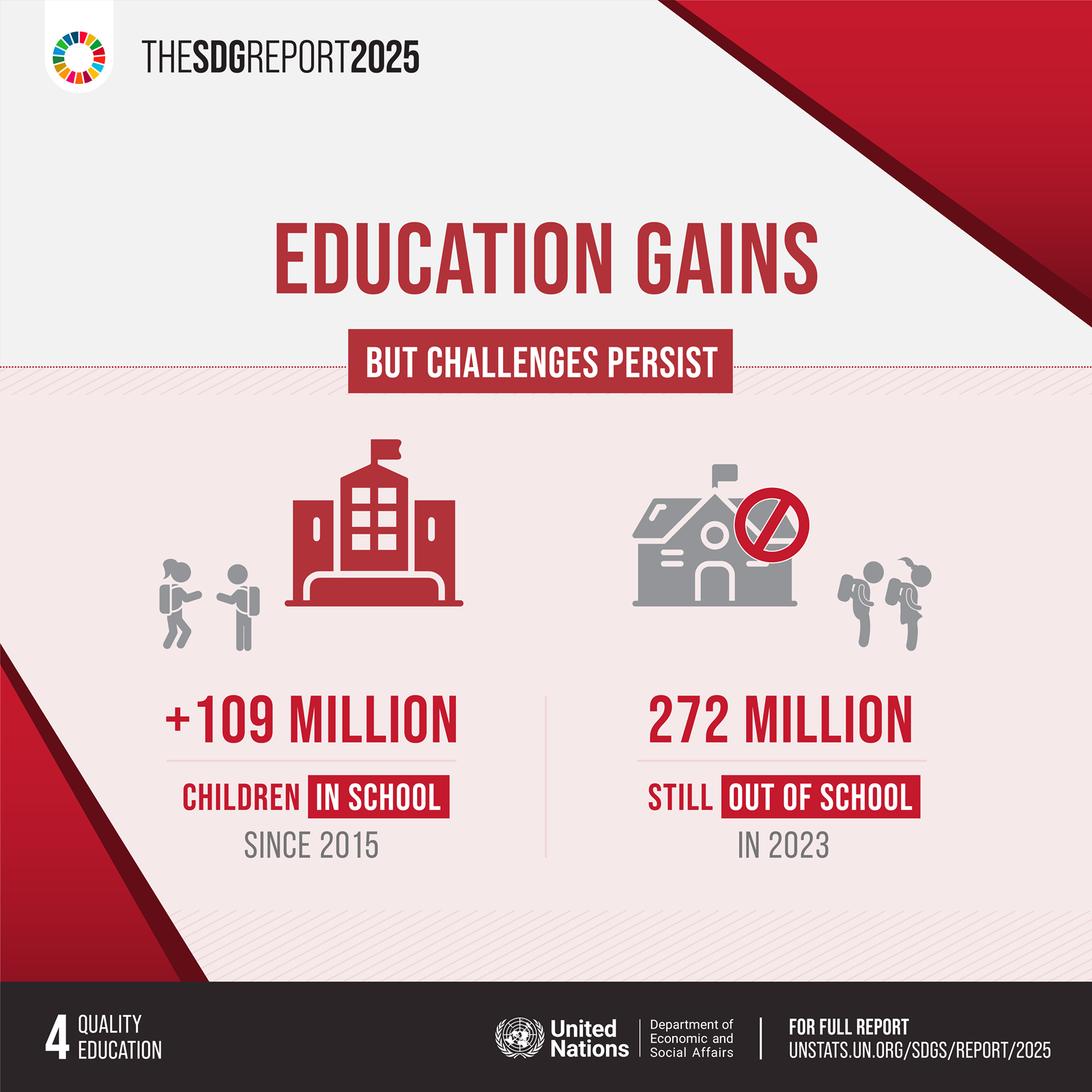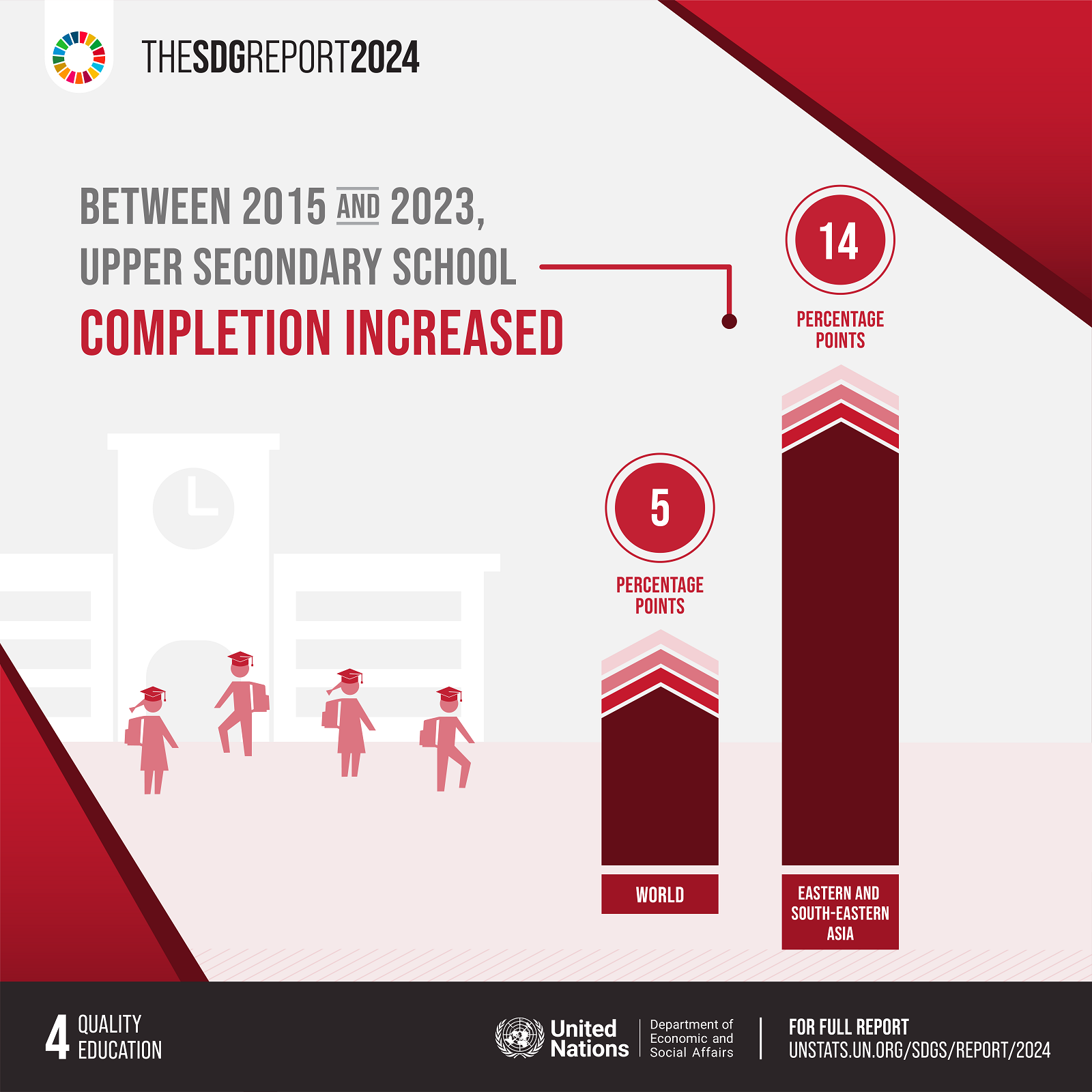Targets and Indicators

4.1
By 2030, ensure that all girls and boys complete free, equitable and quality primary and secondary education leading to relevant and effective learning outcomes
4.1.1
Proportion of children and young people (a) in grades 2/3; (b) at the end of primary; and (c) at the end of lower secondary achieving at least a minimum proficiency level in (i) reading and (ii) mathematics, by sex
4.1.2
Completion rate (primary education, lower secondary education, upper secondary education)

4.2
By 2030, ensure that all girls and boys have access to quality early childhood development, care and pre-primary education so that they are ready for primary education
4.2.1
Proportion of children aged 24–59 months who are developmentally on track in health, learning and psychosocial well-being, by sex
4.2.2
Participation rate in organized learning (one year before the official primary entry age), by sex

4.3
By 2030, ensure equal access for all women and men to affordable and quality technical, vocational and tertiary education, including university
4.3.1
Participation rate of youth and adults in formal and non-formal education and training in the previous 12 months, by sex

4.4
By 2030, substantially increase the number of youth and adults who have relevant skills, including technical and vocational skills, for employment, decent jobs and entrepreneurship
4.4.1
Proportion of youth and adults with information and communications technology (ICT) skills, by type of skill

4.5
By 2030, eliminate gender disparities in education and ensure equal access to all levels of education and vocational training for the vulnerable, including persons with disabilities, indigenous peoples and children in vulnerable situations
4.5.1
Parity indices (female/male, rural/urban, bottom/top wealth quintile and others such as disability status, indigenous peoples and conflict-affected, as data become available) for all education indicators on this list that can be disaggregated

4.6
By 2030, ensure that all youth and a substantial proportion of adults, both men and women, achieve literacy and numeracy
4.6.1
Youth/adult literacy rate

4.7
By 2030, ensure that all learners acquire the knowledge and skills needed to promote sustainable development, including, among others, through education for sustainable development and sustainable lifestyles, human rights, gender equality, promotion of a culture of peace and non-violence, global citizenship and appreciation of cultural diversity and of culture’s contribution to sustainable development
4.7.1
Extent to which (i) global citizenship education and (ii) education for sustainable development are mainstreamed in (a) national education policies; (b) curricula; (c) teacher education and (d) student assessment

4.a
Build and upgrade education facilities that are child, disability and gender sensitive and provide safe, non-violent, inclusive and effective learning environments for all
4.a.1
Proportion of schools offering basic services, by type of service

4.b
By 2020, substantially expand globally the number of scholarships available to developing countries, in particular least developed countries, small island developing States and African countries, for enrolment in higher education, including vocational training and information and communications technology, technical, engineering and scientific programmes, in developed countries and other developing countries
4.b.1
Volume of official development assistance flows for scholarships

4.c
By 2030, substantially increase the supply of qualified teachers, including through international cooperation for teacher training in developing countries, especially least developed countries and small island developing States
4.c.1
Proportion of teachers with the minimum required qualifications, by education level
Progress and Info
Goal 4 remains a critical enabler for sustainable development, yet progress falls short of targets. Improvements in upper secondary completion rates have slowed, while learning outcomes in many countries are declining. Troubling regional disparities exist in early childhood development, and sub-Saharan Africa is at a particular disadvantage. Despite modest improvements in literacy, hundreds of millions of people remain illiterate, and women are disproportionately affected. Teacher qualification challenges persist and there has been minimal improvement since 2015. The rise of digital societies necessitates the integration of technology into education, in order to ensure that young people and future generations have access to relevant, high-quality content that prepares them for the demands of a rapidly evolving labour market. Accelerating progress towards achieving Goal 4 must be prioritized, as it would have a catalytic effect on the realization of the 2030 Agenda overall. Using the impetus of the Transforming Education Summit, convened by the Secretary-General, the United Nations is driving global action towards the achievement of Goal 4, advocating for inclusive, equitable and quality education for all, while supporting efforts to improve learning outcomes and address regional disparities.
Target 4.1 - The percentage of young people completing upper secondary school increased from 53 per cent in 2015 to 60 per cent in 2024, although progress was slower than in the preceding nine-year period. Many countries are moving backwards in terms of learning outcomes at the end of lower secondary school, but large data gaps, especially in early grades, prevent an assessment of broader trends in learning outcomes.
Target 4.2 - Between 2015 and 2024, data from 84 countries indicated that around two thirds of young children were developmentally on track and that there were no significant differences by sex.
Target 4.2 - In 2023, nearly 75 per cent of children worldwide participated in organized learning one year before reaching the official entry age for primary education. That participation rate has remained unchanged since before the pandemic. Currently, only 103 countries guarantee free pre-primary education, and 66 countries mandate at least one year of pre-primary education.
Target 4.3 - Globally, one sixth of individuals between the ages of 15 and 64 recently participated in formal and non-formal education and training. Participation rates were over half for young people between the ages of 15 and 24, but were much lower for older adults, averaging 3 per cent for those in the 25–54 age range.
Target 4.5 - Socioeconomic disparities are evident in many education indicators. Disparities based on location and household wealth are even more pronounced, showing that rural and poorer families experience greater disadvantages. These gaps tend to widen at higher education levels.
Target 4.6 - Some 754 million adults worldwide remained illiterate in 2024, however, with women accounting for 63 per cent of the total. Between 2014 and 2024, the global adult literacy rate (for persons aged 15 and older) increased from 85 to 88 per cent, while the youth literacy rate (for the 15–24 age range) rose from 91 to 93 per cent.
Target 4.a - Over a fifth of primary schools globally do not have access to basic services, such as electricity, drinking water and basic sanitation facilities. The availability of other facilities, such as computers and the Internet for pedagogical purposes, as well as disability-adapted infrastructure, is lower, as half of primary schools lack access.
Target 4.c - In 2023, 15 per cent of teachers worldwide still did not meet their country’s national minimum qualification standards, which means that there had been no improvement since 2015. The situation varied significantly across regions. In sub-Saharan Africa, around two in five teachers did not meet national qualification requirements.

For more information, please visit: https://unstats.un.org/sdgs/report/2025/
More details on SDG 4 in 2025: https://unstats.un.org/sdgs/report/2025/Goal-04/
The 2025 Extended Report on SDG 4 can be found here: https://unstats.un.org/sdgs/report/2025/extended-report/Extended-Report-2025_Goal-4.pdf










